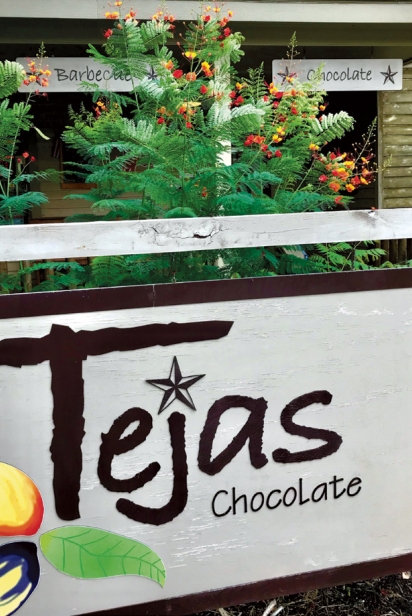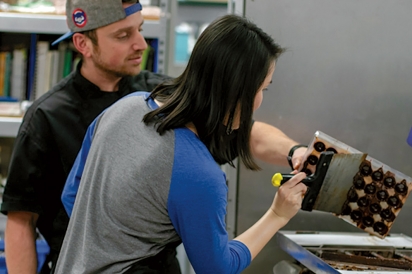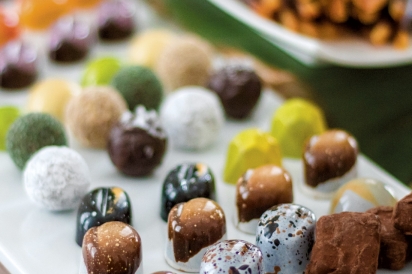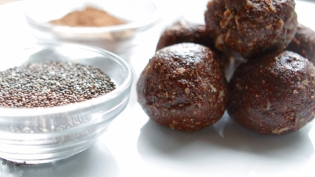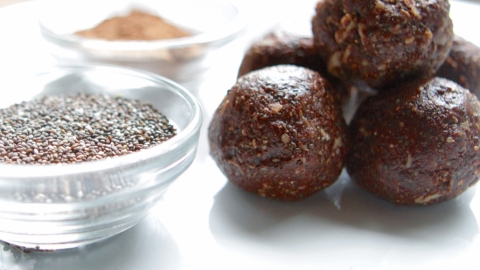Food Fit for the Gods
Swedish natural scientist Carl Linnaeus was onto something when he gave the cacao tree its botanical name: Theobroma— which means food of the gods—cacao. The description is fitting for the tree whose fruit is the raw material used to make chocolate, a food beloved by most for its taste, melt-in-your-mouth texture and that good feeling it gives us when we eat it.
Dating back thousands of years, chocolate was originally consumed only as a drink, first by the Olmec, Maya and Aztec tribes of Mesoamerica and later by Europeans. It wasn’t until the Industrial Revolution that chocolate in solid form was made possible. Mass-produced chocolate became a staple and for hundreds of years it was the norm in America, until a craft chocolate movement was set arose in the early 2000s.
“There was this movement toward fine-flavored cacao, which [involves] starting to understand the nuances of flavor within chocolate, instead of having it taste like just one thing,” said Annie Rupani, the chocolatier behind Cacao & Cardamom in Houston.
Unlike mass-produced chocolate, which aims for consistency in flavor, craft chocolate makers bring out the diversity of flavors found in cacao from different origins. A bar made with cacao beans from Madagascar, for instance, will have red fruit and citrus notes, while one made with cacao from Bolivia may have notes of peat and moss.
Rupani fell in love with chocolate while in college. She turned to it when she needed a semi-healthy snack, seeking single-origin bars— meaning they’re made with cacao beans from just one place—from countries like Colombia, Bolivia and Granada. She wanted to make chocolate from bean to bar, but for a law student, the highly involved process of making chocolate from scratch was too much. “It’s a lot of manipulating, from the moment you get the raw bean,” she explained.
Indeed, the process of transforming cacao beans into good chocolate is technical and complex. One could say it all starts at the farm. As with wine and coffee, the terroir—the location of the tree, the characteristics of the soil and the amounts of rainfall and sunlight—influences the flavor of the bean. So does the post-harvest treatment of the bean. After cacao pods are harvested from the tree, their seeds are removed from the pod, fermented in banana leaves or wooden boxes and then dried. Fermentation begins to develop flavors in the bean that are unique to its origin. Then, the chocolate maker comes in.
Scott Moore Jr., chocolate maker at Tejas Chocolate + Barbecue in Tomball, became intrigued by chocolate in 2010 after watching a TV show about the Brooklyn-based Mast brothers. He didn’t care much for chocolate bars at the time, because he “had never really had a good one,” but the show inspired him to order some artisanal chocolate online. “I was pretty freaked out about how good it was,” said Moore.
At a crossroads in his career, he decided to give chocolate making a try. He and his wife, Michelle Holland, started selling his bars at the Tomball Farmers Market and online in 2011. Chocolate enthusiasts and stores like Central Market and Whole Foods quickly took note. Tejas Chocolate was the first bean-to-bar chocolate maker in Texas and remains one of only two in the Houston area.
Once a chocolate maker like Moore receives the cacao beans, their road to becoming a bar of chocolate is nowhere near complete. First, Moore sorts the beans by hand to select the best ones. Then, he roasts them low and slow in a drum roaster inside a clay brick oven. The cacao beans turn gently over the heat, developing flavor as they roast.
Once roasted, the shell of the bean is removed, leaving only the cacao nib. The nibs are ground in a stone grinder, refined and conched. The chocolate is then left to rest and age. “Some chocolates are very enjoyable in about a week or two and some need eight months to rest and age to really improve,” Moore said.
The final step is tempering, which takes the chocolate from a mosaic-like, crumbly nature to a snapping, glossy finish. Once tempered, the chocolate is poured into molds and wrapped.
While Tejas may be better known among Houstonians now for its barbecue, Moore points out that the barbecue came about to support his chocolate making. As customers line up at his restaurant to buy smoked meats, they get to stare at a case of chocolate and are tempted to try. “We’re using barbecue to introduce people to fine chocolate,” said Moore.
At Cacao & Cardamom, Rupani uses fine chocolate to make beautiful tiny pieces of art, painted in shiny bright colors and filled with exotic flavor combinations influenced by her South Asian background and travels. Think cardamom rose, coconut curry and black sesame ginger.
“Chocolate is such a great medium for flavors that don’t exist in it currently, and so to make bonbons was a lot more fun to me than for me to think about what temperature I was roasting the cacao beans,” she said.
Because dark chocolate has been lauded for its health properties, many people request it, but that can be a struggle for creative chocolatiers who like to develop confections based on which chocolate pairs well with certain flavors, not how dark the chocolate is.
Still, the demand for dark chocolate is not unfounded. Countless articles have been written about its nutritional benefits and superfood status. According to dietician Ali Miller of Naturally Nourished in Houston, cacao has a high concentration of antioxidants and contains theobromine, a unique alkaloid compound that together with minerals present in cacao, such as magnesium and zinc, can boost one’s mood, promote lower blood pressure and relax muscles.
Dany Kamkhagi, head chocolatier at Mostly Chocolate, a family-owned catering company and chocolatier, loves introducing skeptics to good white or milk chocolate. To customers who say they eat only dark chocolate, he offers his goat cheese truffle, which has a dark chocolate shell and a filling that contains white chocolate. They typically love it.
“Right now, you have dark chocolate as a trend,” he said. “You go to a place like Central Market and you see 150 different varieties of dark chocolate bars, right? But you maybe see one good-quality milk chocolate bar.”
When made right and with high-quality ingredients, white and milk chocolate can be an enjoyable treat. Some chocolate makers have even started making dark milk chocolate bars, which contain 60% cacao—meaning that percentage of the bar, by weight, is made from cacao and cacao products.
Kamkhagi joined his Lebanese parents’ catering business in 2011, helping out with various tasks, but a two-week internship with a Swedish chocolate maker in New York took him down a path he hadn’t really expected. “The second I walked into their kitchen, it changed my life,” he recalled.
In 2015, he became the head chocolatier at Mostly Chocolate. Upon his return from New York, he spent time honing the skills he had learned, hand tempering the chocolate on a marble table and going through a lot of trial and error to perfect his craft. Like Moore and Rupani, Kamkhagi focuses on using highquality ingredients and treating them right, even when chocolate making can be as challenging as a relationship.
“It’s moody sometimes... You can do the same thing 10 times and all of a sudden it’s starting to act differently, and then you have to think of the temperature in the room, and this and that,” he said. “Every day you learn something.”
Very few of us think about the work that has gone into making that craft chocolate bar we so love or that delicious bonbon we’re enjoying. At Mostly Chocolate, Kamkhagi hosts bonbon-making workshops for this very reason. Yes, they’re a fun way to spend an evening, but Kamkhagi uses them as an opportunity to give people a glimpse into the chocolate industry—from the raw materials used, to the process of making chocolate, to why it will cost more to eat a truffle made with fine-flavored cacao or a handcrafted, single-origin bar than, say, a Hershey’s chocolate.
So next time you eat a piece of good chocolate, think about where it came from—its origins and the farmers, chocolate makers and chocolatiers who put great care into bringing out the best qualities in this food fit for the gods.



